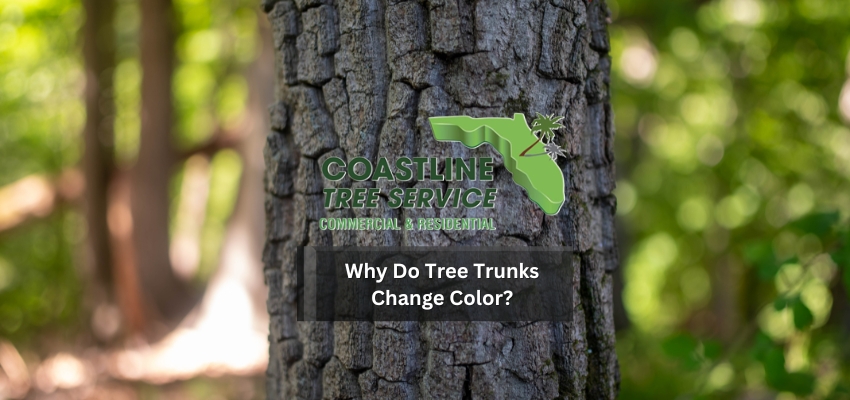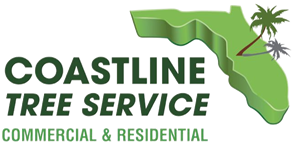
Unveiling the Mystery: Why Tree Trunks Turn Black and How to Restore Tree Health
Here in SW Florida, trees are an essential part of our environment, providing shade, beauty, and health benefits. However, when trees show signs of distress, such as a blackened trunk or leaves, it can be concerning. In this comprehensive guide, we’ll explore why a tree trunk may turn black, the common causes of blackening leaves and bark, and how Coastline Tree Service’s certified arborists in Fort Myers can help address these issues for your home, HOA community or business property landscape.
Understanding Blackened Tree Trunks
A blackened tree trunk is often a sign of a fungal infection or other disease affecting the tree. One of the most common culprits is sooty mold, a type of fungus that grows on the honeydew excreted by aphids or scale insects. This mold can cover the trunk and branches, giving them a blackened appearance.
Causes of Sooty Mold
Sooty mold thrives in environments where sap-sucking insects are present. These insects feed on the tree’s sap and excrete a sugary substance called honeydew, which provides a perfect breeding ground for sooty mold. The mold itself does not directly harm the tree but can impede photosynthesis by blocking sunlight.
Common Diseases Causing Blackening of Leaves and Bark
Several diseases can cause the blackening of leaves and bark. Here are some of the major ones:
1. Fire Blight
Fire blight is a bacterial disease that affects many species of trees, particularly those in the rose family. It causes leaves, flowers, and branches to turn black and appear scorched. The bacteria enter through wounds or natural openings and spread rapidly.
Prevention and Treatment
- Pruning: Remove and destroy affected areas to prevent the spread.
- Antibiotic Sprays: Use as a preventive measure during the growing season.
- Professional Help: A certified arborist can diagnose and recommend appropriate treatments.
2. Black Knot
Black knot is a fungal disease that primarily affects cherry and plum trees. It forms hard, black galls on the branches, which can eventually girdle and kill them if left untreated.
Prevention and Treatment
- Pruning: Remove infected branches during the dormant season.
- Fungicides: Applied in early spring to protect new growth.
- Professional Help: An arborist can correctly identify the disease and prune effectively.
3. Sooty Canker
Sooty canker is caused by the fungus Hendersonula toruloidea and affects a wide range of tree species. It results in blackened, sunken lesions on the trunk and branches, often with a powdery black appearance.
Prevention and Treatment
- Sanitation: Remove infected wood and improve tree vigor through proper watering and fertilization.
- Fungicide Treatments: May be recommended by a professional.
- Professional Help: A certified arborist can provide an accurate diagnosis and treatment plan.
Major Causes of Blackening Leaves
The blackening of leaves can be attributed to several factors, including:
1. Fungal Infections
Fungal infections, such as anthracnose, can cause leaves to develop black spots. These fungi thrive in wet, humid conditions and can spread quickly.
Prevention and Treatment
- Proper Watering: Avoid overhead watering to reduce humidity.
- Fungicides: Apply as directed to control the spread.
- Professional Help: Arborists can identify the specific fungus and recommend treatments.
2. Environmental Stress
Environmental stress, such as drought, excessive moisture, or nutrient deficiencies, can cause leaves to turn black and fall off.
Prevention and Treatment
- Proper Care: Ensure the tree receives adequate water, nutrients, and protection from extreme weather.
- Soil Testing: Conduct soil tests to determine any deficiencies.
- Professional Help: An arborist can assess and recommend measures to mitigate environmental stress.
How Coastline Tree Service’s Certified Arborists Can Help
At Coastline Tree Service, we understand the importance of maintaining healthy trees. Our certified arborists are trained to diagnose and treat a wide range of tree diseases and conditions. Here’s how we can assist:
Comprehensive Diagnosis
Our arborists conduct thorough inspections to identify the exact cause of the problem. This includes assessing the tree’s overall health, examining symptoms, and conducting necessary tests.
Customized Treatment Plans
Based on the diagnosis, we develop a tailored treatment plan to address the specific issue. This may include pruning, applying fungicides or insecticides, improving soil conditions, or other interventions.
Preventive Care
We offer preventive care services to keep your trees healthy and resilient against diseases and pests. This includes regular inspections, proper watering and fertilization, and timely pruning.
Expert Advice and Support
Our team provides expert advice on tree care practices and offers support throughout the treatment process. We ensure that you are well-informed and confident in the care your trees receive.
Consider Coastline Tree Service & Give Us A Call
Blackened tree trunks and leaves are clear indicators that a tree is in distress. Understanding the causes and seeking professional help can make a significant difference in preserving the health and beauty of your trees. Coastline Tree Service in Fort Myers is committed to providing top-notch care with our certified arborists who are ready to tackle any tree-related issue.
We proudly serve and offer Tree Landscape Management Services in Naples, Marco Island, Bonita Springs, Estero, Fort Myers, Fort Myers Beach, North Fort Myers, Cape Coral, Sanibel & Punta Gorda.
Give us a Call at: (239) 895-3230 or contact us online at: https://www.coastlinetree.com/contact-us/.
Together, we can ensure that your trees stand strong & healthy.
